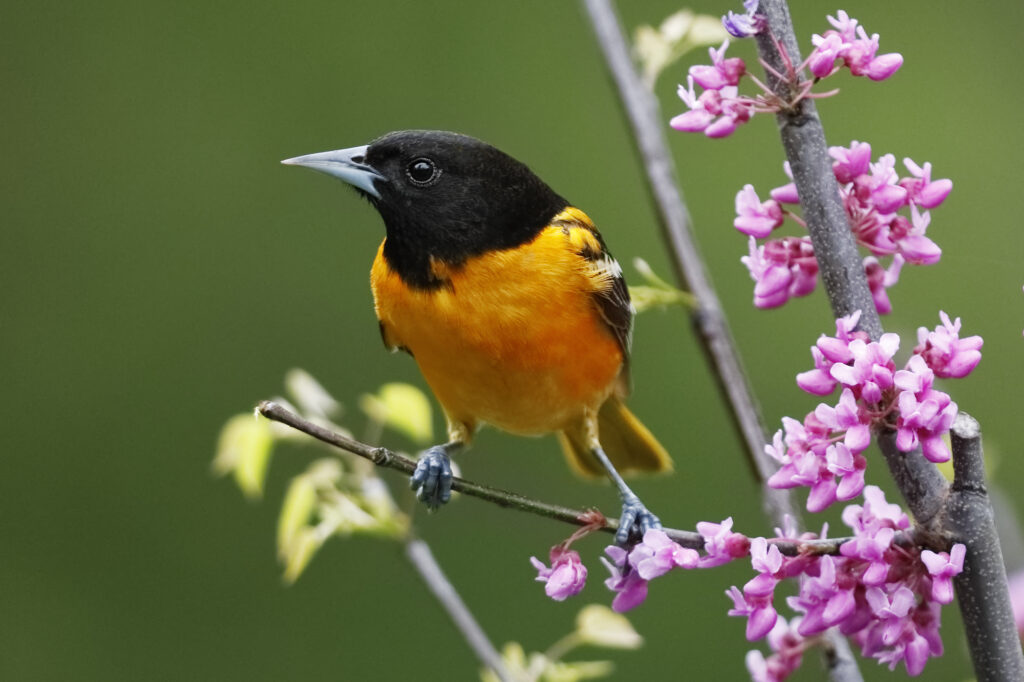Something that’s common to many blackbirds is that they love watery habitats. But usually, that means freshwater habitats, like wetlands and river valleys.
North Carolina’s coastal region means the state is treated to some unique beach-loving blackbird species that aren’t commonly seen elsewhere.
In addition, North Carolina is home to a wide range of the flashy, feisty, and fascinating birds of the blackbird, or Icteridae, family.
So what exactly is a blackbird?
Not All Black Birds are Blackbirds
You might expect that a family of blackbirds would be named for its black wings, but when it comes to their scientific name, they’re actually not.
The name “Icterid” means “the jaundiced ones”, which sounds none-too-flattering! It refers to the flashy yellow feathers that many members of the blackbird family also have.
In ancient Greece, it was believed that a yellow-feathered bird could cure jaundice and that folklore association made its way into the scientific name of this new world bird family.
In addition to these bright yellow feathers, many blackbirds have extremely colorful bodies, thanks to their natural iridescence. Their black feathers can show flashes of many other colors, including ranges of blues, greens, and purples.
Blackbirds are good at finding trouble, whether with humans or each other. They scavenge food, expand into urban areas, and are aggressive birds—shouldering their way into bird feeders.
Some even lay their eggs in other birds’ nests! Others practice social domination to get the best breeding grounds.
Which blackbirds can you see in North Carolina? Let’s find out more about them!
Eastern Meadowlark

- Length: 7.5 – 10.2 in (19 – 26 cm)
- Weight: 3.2 – 5.3 oz (90 – 150 g)
- Wingspan: 13.8 – 15.8 in (35 – 40 cm)
Color Pattern: Eastern Meadowlarks have a sunny yellow breast with a distinctive black v-marking at the chest. The rest of the body is pale brown with black markings. The tail is brown with blackish barring, and white wing bars that become noticeable during flight.
The Eastern Meadowlark may be a little more mysterious than your average blackbird. They’re not as common to see at bird feeders.
It’s not easy to find an Eastern Meadowlark’s nest: these medium-sized blackbirds will walk back to their nests through narrow grass runways, rather than fly.
These birds like open grasslands, meadows, and pastures, and can be seen throughout North Carolina year-round. Look for them in grasses 5”-12” high.
Baltimore Oriole
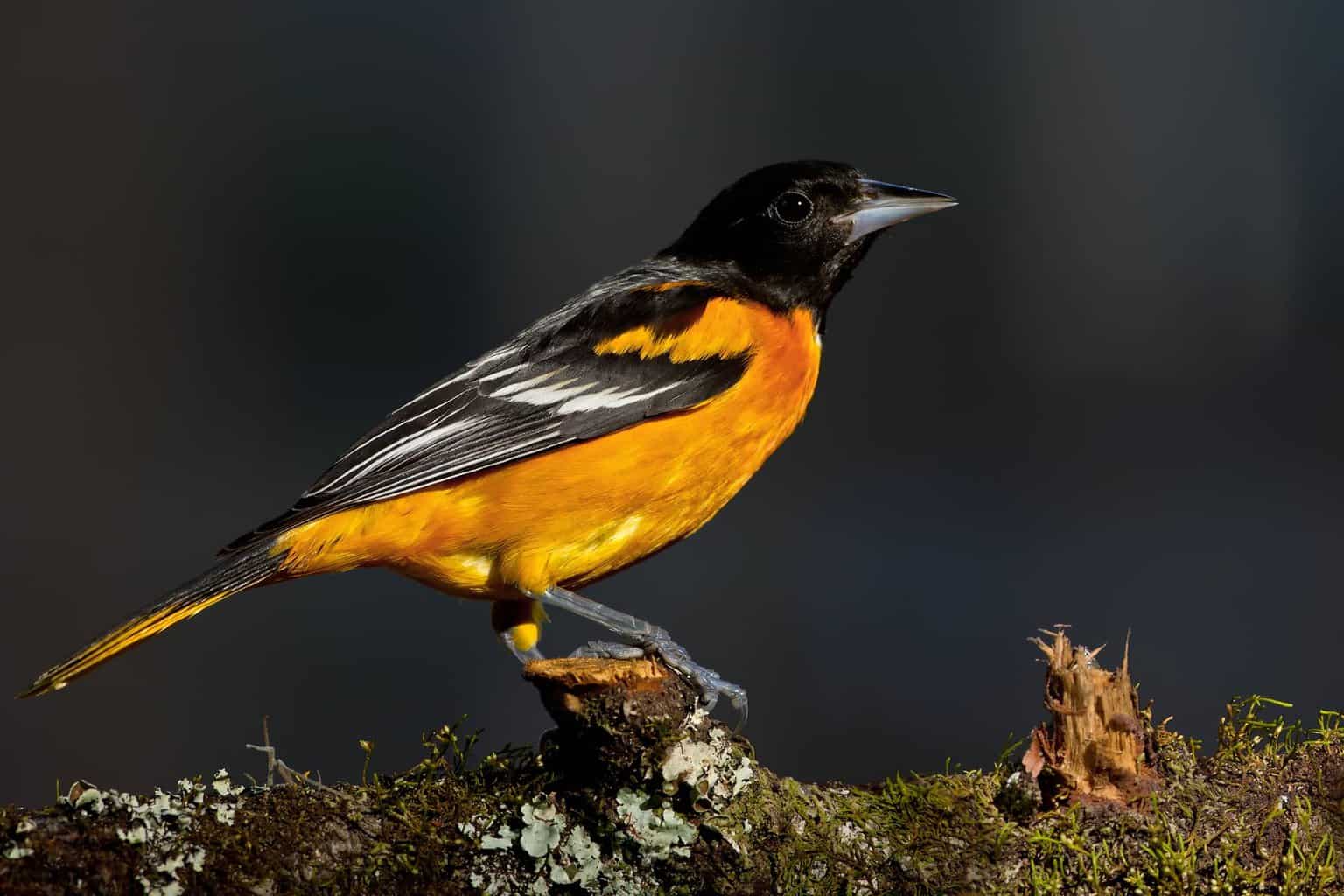
- Length: 6.7 – 7.5 in (17 – 19 cm)
- Weight: 1.1 – 1.4 oz (30 – 40 g)
- Wingspan: 9.1 – 11.8 in (23 – 30 cm)
Color Pattern: Adult males have striking bright orange undersides, and a black hood, back, and wings. They are medium-sized blackbirds that have white wing bars and white streaking on the wings.
Adult females are olive to gray on their backs with subdued yellowish-orange undersides. They share the white wing bars and streaking of the males. Juveniles share the female coloration.
Baltimore Orioles migrate to North Carolina to nest in the mountain regions during the summer. As they pass through, you’ll see them throughout the rest of the state in the spring and fall.
When orioles are on the move, they are looking for one thing above all others: sugar! They love fruit, nectar, and even grape jelly. You can feed them specialized nectar feeders like those used for hummingbirds, or simply slice some oranges in half.
Orchard Oriole

- Length: 5.9 – 7.1 in (15 – 18 cm)
- Weight: 0.6 – 1.0 oz (16 – 28 g)
- Wingspan: 9.8 in (25 cm)
Color Pattern: The adult male is black on top from hood to tail, with a deep chestnut-colored underside. There is a chestnut-colored patch on each wing, with white wing bars.
Adult females are medium-sized blackbirds with an olive-to-yellow back that gets more yellow on the underside. Their wings are grayish and marked with two white wing bars; unlike the males, they have no black markings.
Juvenile Orchard Orioles are similar to females, but immature males have black markings on their faces.
Orchard Orioles are common in North Carolina, but there are a couple of reasons why you might not spot them. They like to perch high up, so be sure to check treetops.
Orchard Orioles fly south for the winter early, so look for them during the warmest part of the summer.
Orchard Orioles are also shy at the birdfeeder, so you’re less likely to see them there. But if you put out favorites like orange slices, grape jelly, or plants that bear dark fruit like mulberries, you might lure these reclusive birds to your yard.
Red-Winged Blackbird
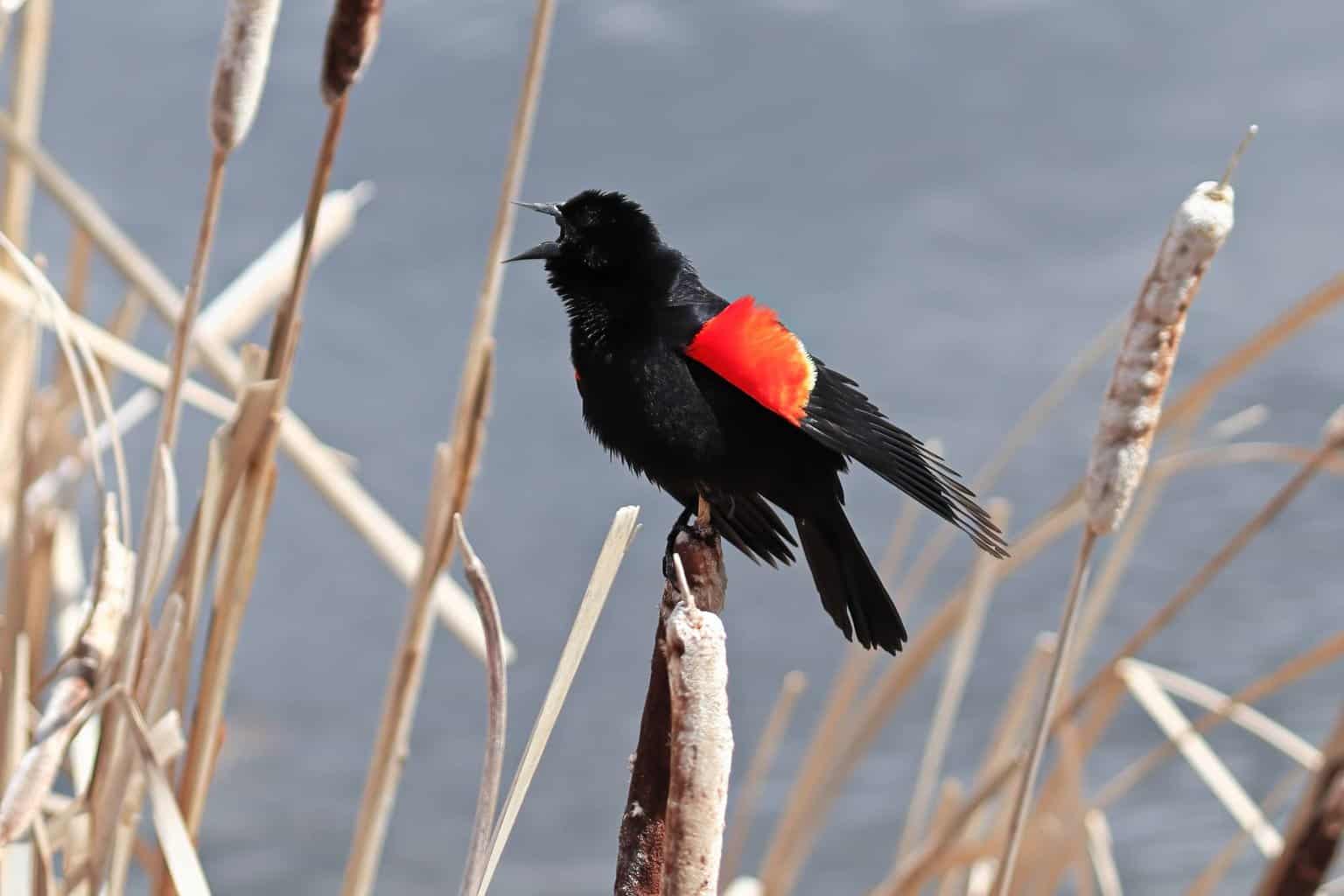
- Weight: 1.1 – 2.7 oz (32 – 77 g)
- Wingspan: 12.2 – 15.8 in (31 – 40 cm)
Color Pattern: The males are striking in appearance, with glossy black bodies, and red and yellow markings on the curve of each shoulder.
Female Red-Winged Blackbirds are dark brown overall, with white wing bars, a pale breast, and often, a white eyebrow.
Like many of their blackbird brethren, these birds love any kind of wetlands in North America. While Red-Winged Blackbirds are commonly found in every county of North Carolina, during the breeding season, they move to areas with ponds and marshes.
In the winter, they are not often seen in the mountains.
Even though males will fiercely defend territories with as many as 15 different female mates, the chicks from one nest often have several different fathers.
Brown-Headed Cowbird
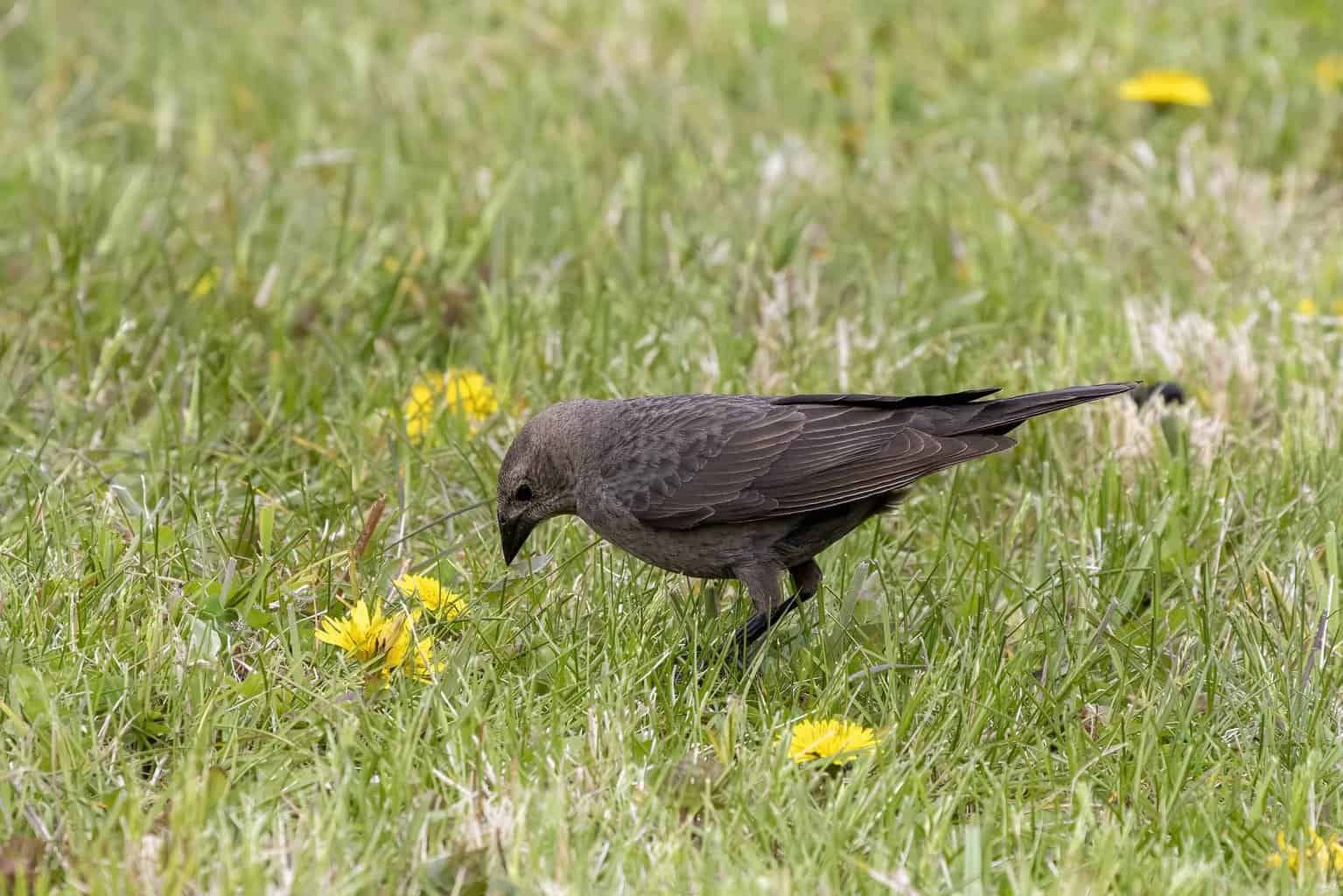
Male
- Length: 7.5 – 8.7 in (19 – 22 cm)
- Weight: 1.5 – 1.8 oz (42 – 50 g)
- Wingspan: 14.2 in (36 cm)
Female
- Length: 6.3 – 7.9 in (16 – 20 cm)
- Weight: 1.3 – 1.6 oz (38 – 45 g)
- Wingspan: 12.6 – 15.0 in (32 – 38 cm)
Color Pattern: Males have glossy black feathers all over their bodies, and a deep brown head that can look black from a distance.
Female Brown-Headed Cowbirds are entirely brown, but lighter on their heads and undersides. They have dark eyes and fine streaks on their bellies.
The most distinctive trait of Brown-Headed Cowbirds is that they are brood parasites: that is, they lay their eggs in other birds’ nests. They then make their chicks someone else’s problem!
The Brown-Headed Cowbirds aren’t picky about the adoptive parents they choose—they will lay their eggs in the nests of over 220 different host species.
But it seems that an individual female Brown-Headed Cowbird will select one host species to lay her eggs with consistently during the breeding season.
Rusty Blackbird
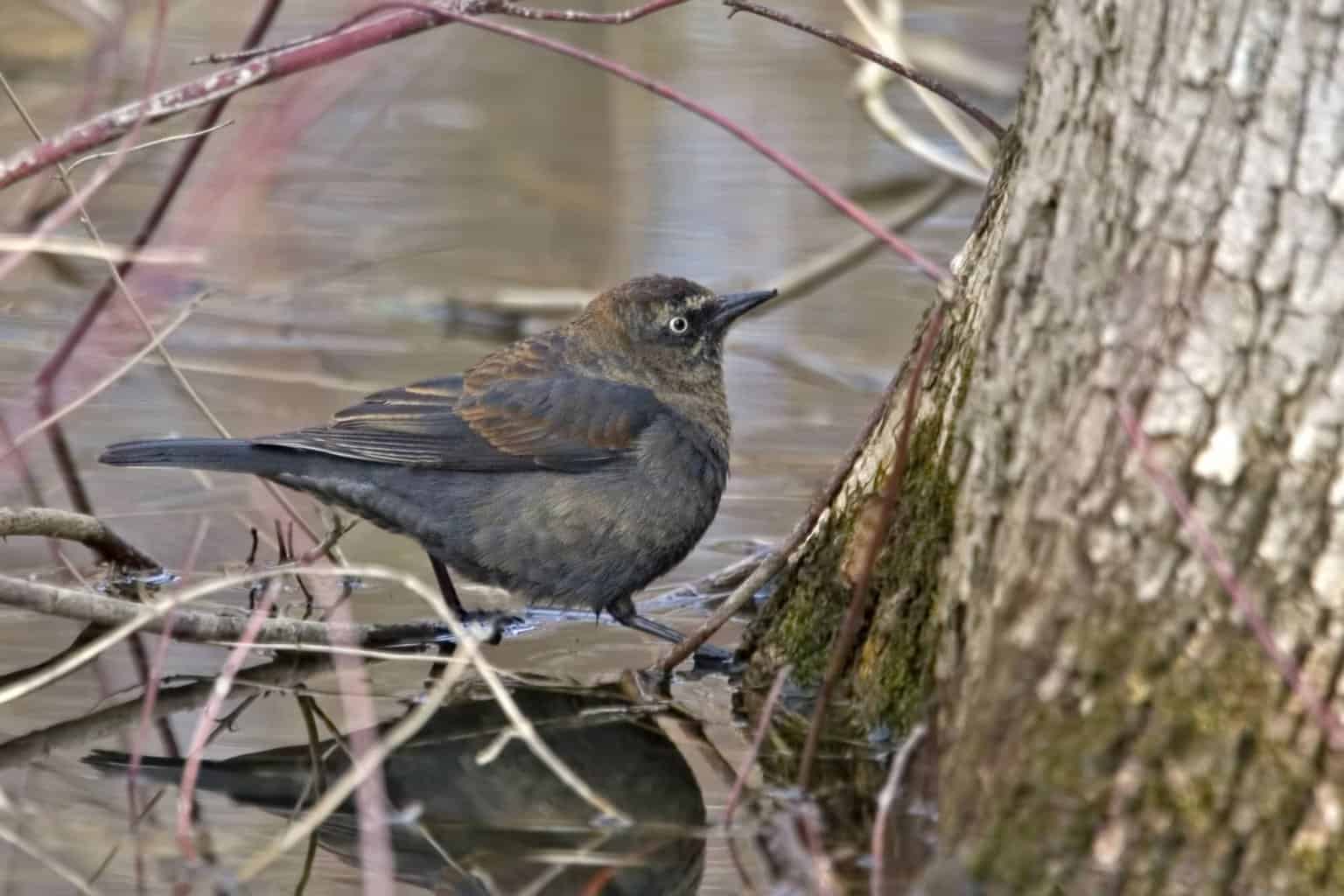
- Length: 8.3 – 9.8 in (21 – 25 cm)
- Weight: 1.7 – 2.8 oz (47 – 80 g)
- Wingspan: 14.6 in (37 cm)
Color Pattern: The Rusty Blackbird is recognizable by the rusty feather edges that are visible on both the non-breeding males and the females. Both also have pale yellow eyes. Non-breeding males have buffy eyebrows.
Female Rusty Blackbirds have gray-brown bodies and dark feathers surrounding the eye that contrast with a pale brow.
Breeding males are glossy black all over, with a greenish iridescent sheen.
Rusty Blackbirds breed in the far north, then winter along the southern east coast and in the Mississippi River Valley. In North Carolina, you will find the most Rusty Blackbirds in the Coastal Plain and Piedmont regions.
The Rusty Blackbird is in serious trouble. This bird’s numbers declined 85 to 95% over a span of 40 years–more than any other North American songbird.
The International Rusty Blackbird Working Group is studying these birds and trying to solve the troubling problem of their decline. They’re asking for residents of southeast North America to help by sharing any sightings of the Rusty Blackbird.
Brewer’s Blackbird
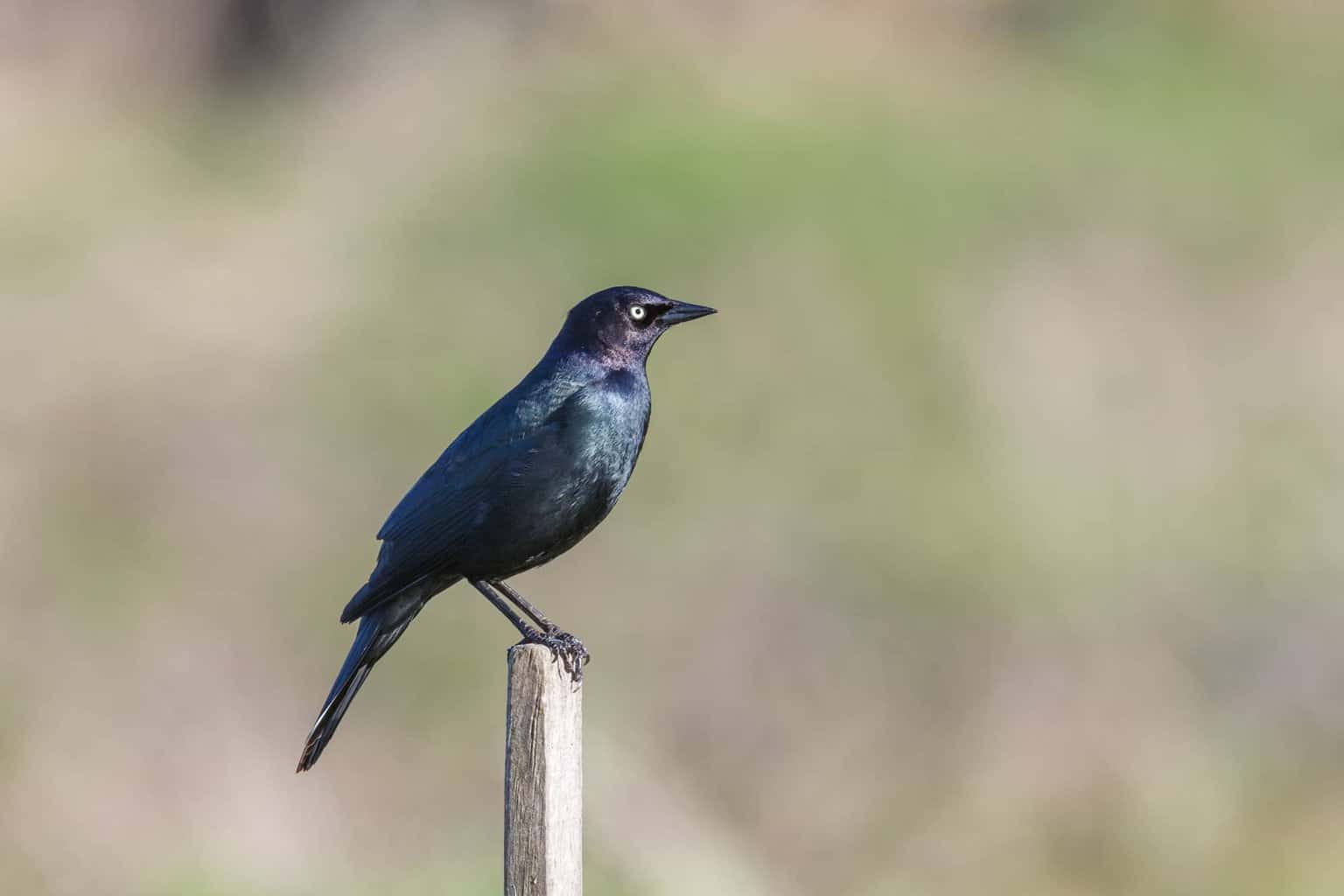
Male
- Length: 8.3 – 9.8 in (21 – 25 cm)
- Weight: 2.1 – 3.0 oz (60 – 86 g)
- Wingspan: 14.6 in (37 cm)
Female
- Length: 7.9 – 8.7 in (20 – 22 cm)
- Weight: 1.8 – 2.4 oz (50 – 67 g)
- Wingspan: 14.6 in (37 cm)
Color Pattern: Males are iridescent black, ranging from blues at the top of their head, down to greens lower on their body. They have striking yellow eyes.
Females are brown throughout, but darker on their tails and wings. They have dark eyes. Juveniles will look similar to the females, but with washed-out coloration.
Brewer’s Blackbirds are uncommon winter visitors to North Carolina, which is generally too far east for their range.
When they do visit North Carolina, they tend to gather in central Carteret county, for reasons that aren’t fully understood. They also will join larger flocks of other blackbird species passing through the state.
Brewer’s Blackbirds adapt well to the human development of their habitat and don’t seem to mind sharing urban North American landscapes with us.
Common Grackle

- Length: 11.0 – 13.4 in (28 – 34 cm)
- Weight: 2.6 – 5.0 oz (74 – 142 g)
- Wingspan: 14.2 – 18.1 in (36 – 46 cm)
Color Pattern: Common Grackles seem to be simply black, but iridescence gives them a wide array of colors under the right light.
Males have glossy purple heads and bronzing all over their bodies. Females aren’t as iridescent as the males, but still have some of that bronzing and multicolored sheen.
Both adults have light golden eyes, but juveniles are born with dark eyes.
Common Grackles are intelligent, noisy birds that are known for their wide-ranging appetites and foraging skills.
They will eat just about anything, whether that means insects, seeds, vegetables, fish, eggs, or even other birds and small rodents.
These highly-social birds with black wings will form multi-species flocks in the winter with other types of blackbirds, sometimes including several million birds. They forage and spend the breeding season together.
Boat-Tailed Grackle
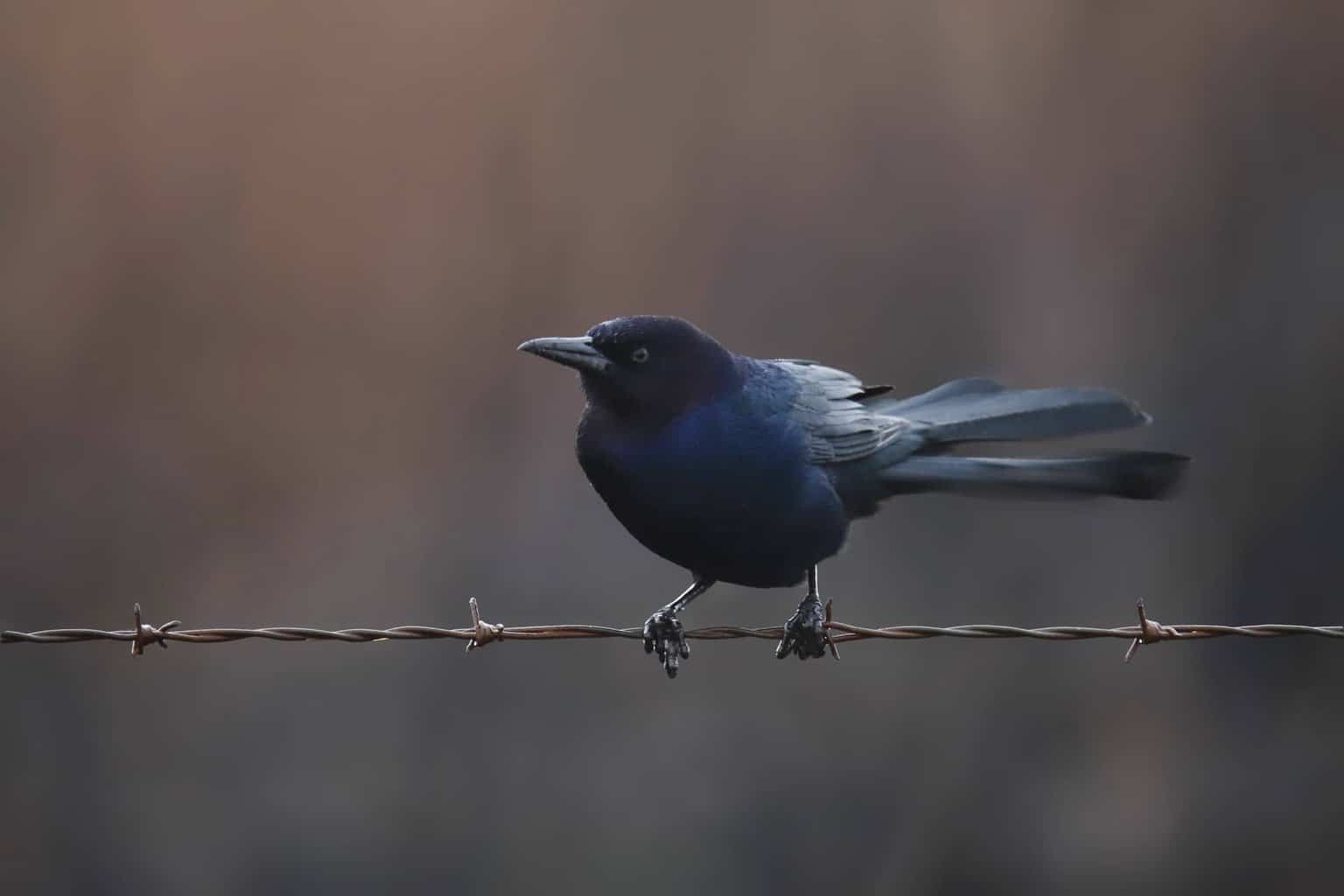
- Length: 10.2 – 14.6 in (26 – 37 cm)
- Weight: 3.3 – 8.4 oz (93 – 239 g)
- Wingspan: 15.3 – 19.7 in (39 – 50 cm)
Color Pattern: Adult males have iridescent purple heads with glossy black bodies and black wings.
Females are brown all over, darker on their backs, and brighter on their undersides. They have pale “mustache” eyebrow markings and dark cheeks.
Both adults have an eye color that varies by region. Along the western Gulf Coast, it’s a dull brown, changing into a bright yellow patch along the Atlantic Coast.
This bird is a native bird to North Carolina’s Coastal Plain. Boat-tailed Grackles favor scrub thickets, mud flats, and beach shores.
It was once thought that the Boat-Tailed Grackle was the same species as the Great-Tailed Grackle, but in the 1970s it was discovered that the two species meet in Texas and Louisiana without breeding.
If a Boat-Tailed Grackle fledgling falls out of its nest into the water, it can actually swim. The chicks are raised by the female and are ready to leave the nest after only two weeks.
Concluding Thoughts
Whether it’s the coast-hugging Boat-Tailed Grackle, the sugar-rushing orioles, or the lazy parenting Brown-Headed Cowbird, North Carolina’s blackbirds offer many fascinating native birds for any birder. Exploring the world of the blackbirds can start in your own backyard. Enjoy!

